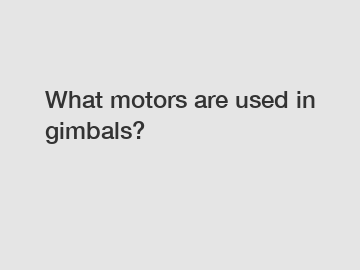What motors are used in gimbals?
What Motors Are Used in Gimbals?
Gimbals are crucial components in the world of photography and videography, allowing for smooth and stabilized camera movements. These devices are commonly found in drones, handheld gimbals, and even professional cinema cameras. But have you ever wondered what motors are used in gimbals to achieve that seamless operation? In this article, we will explore the different types of motors that you can find in gimbals and how they contribute to their functionality.
Brushless DC Motors (BLDC).

BLDC motors are widely used in gimbals due to their high efficiency, compact size, and low maintenance requirements. These motors utilize a permanent magnet rotor and a series of electromagnets on the stator to generate motion. Unlike their brushed counterparts, the commutation of these motors occurs electronically, resulting in a higher efficiency and longer lifespan.
BLDC motors used in gimbals are usually three phase, with each phase energized in a sequence to create a rotating magnetic field. They can be controlled using pulse-width modulation (PWM) signals to adjust their speed and position accurately. The advantage of BLDC motors in gimbals is their ability to provide precise and smooth movements, ensuring stable footage even in challenging conditions.
Direct-Drive Motors.
Direct-drive motors, also known as torque motors or pancake motors, are another popular choice for gimbals. These motors offer a wide range of advantages, including high torque output, zero backlash, and exceptional precision. Direct-drive motors eliminate the need for gears or belts, which are often sources of mechanical noise and potential failure points. By directly coupling the motor to the gimbal axis, it achieves a higher level of accuracy and responsiveness.
These motors are typically brushless and operate as a hub motor, meaning the rotor surrounds the stator. This design provides a larger surface area for heat dissipation, making it suitable for demanding applications. Direct-drive motors are commonly used in high-end gimbals, where precision and reliability are of utmost importance.
Stepper Motors.
Stepper motors are characterized by their ability to move in discrete steps or increments. They are widely used in various applications that require precise positioning, such as 3D printers and CNC machines. While not as common in gimbals as BLDC or direct-drive motors, stepper motors can still be found in entry-level or budget-friendly gimbal systems.
One advantage of stepper motors is their simplicity and cost-effectiveness. They offer high holding torque and can maintain position even when power is removed. However, they may not be as smooth or responsive as other motor types, which can result in less fluid camera movements.
Closing Thoughts.
In conclusion, gimbals rely on different types of motors to achieve smooth camera stabilization and precise movements. The choice of motor depends on factors such as the gimbal's purpose, budget, and desired performance. Brushless DC motors are commonly used due to their efficiency and compact size. Direct-drive motors provide superior accuracy and eliminate the need for gears and belts. Stepper motors, although less common, offer cost-effectiveness and holding torque.
If you have any further questions or need assistance with gimbals and their motors, feel free to contact us. Our team of experts is here to help you find the best solution for your specific needs.
Contact us today to learn more about motors used in gimbals and enhance your photography or videography experience to a whole new level.
For more tmotor f80, light motor, f-90information, please contact us. We will provide professional answers.

Comments
0